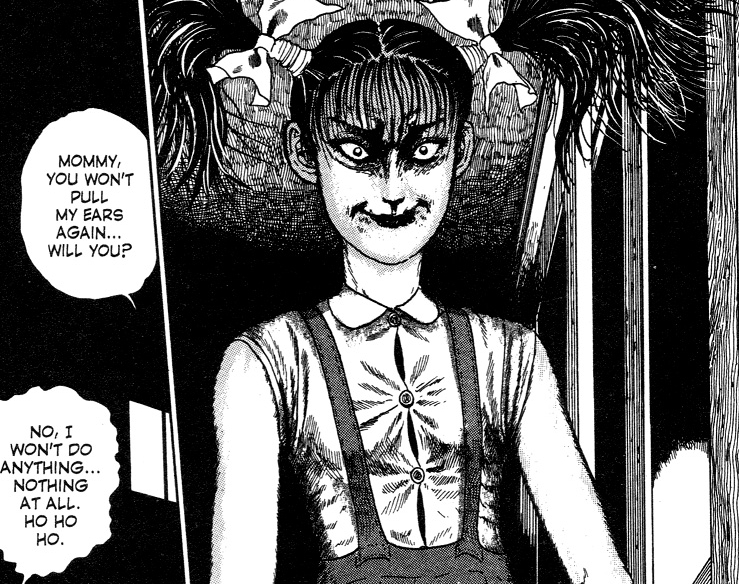 Yay, twelve Junji Ito one-shot stories. This format is where Ito is most comfortable. His style is visceral and intense and works best in small doses. Also, it’s hard to care about slightly flat characters when you only spend 20-30 pages with them.
Yay, twelve Junji Ito one-shot stories. This format is where Ito is most comfortable. His style is visceral and intense and works best in small doses. Also, it’s hard to care about slightly flat characters when you only spend 20-30 pages with them.
Ito loots ideas from all manner of places: childhood phobias, ancient myths, Lovecraftian existential terror. There’s no unified theme running through these stories, except perhaps that you should be careful picking up rocks. No matter how safe and familiar a rock might look, there’s always something squirmy and chitinous and unpleasant on the damp side.
“The Bully” is one of Ito’s most frightening tales. No gore, nothing supernatural, just a really powerful psychological tale of childhood trauma following two people long after they’ve grown up and left the schoolyard behind them. It doesn’t matter that we never find out what happened to the woman’s husband. The consequences of his disappearance are enough. “The Devil’s Logic” is equally powerful. A girl climbs to the top of a school building and throws herself to her death, and only one of her classmates knows the reason why. Ito is just on fire in these two stories.
“A Deserter in the House” is pretty fun. A WWII-era Japanese family is harbouring an army deserter in their basement. Since he never leaves the house, they fuck with him by feeding him all sorts of fake news about the war (Japan is winning the war, America is on the verge of surrender, etc…). This is about as good as you get character-wise with Ito. The family is a diverse cast with some understandable (if cruel) motives, and we’re not sure whether to pity or hate the deserter. Unfortunately, Ito wraps up the story on a dull note. I wish it had ended as well as it started.
“Den of the Sleep Demon” is a vile retelling of Jekyll and Hyde, featuring a man with a hellish force of evil inside him (literally inside him), and a girlfriend who helps him fight back. “Love as Scripted” is also very cool. A girl dates an actor, and finds that she likes his stage presence far more than the real thing. It raises the interesting question of whether love for something fake (whether it’s a fictional character, or a real person putting on a fake persona) is any more or less valuable than love for the real thing.
A handful of stories fall short of the mark. “Sword of the Reanimator” is shitty shonen fluff featuring magic swords, ancient legacies, epic boss battles, and all the rest. I have no idea why Ito wrote this story, it’s just inexplicable and awful. Probably his editor made him do it. “The Face Burgler” is about a high school girl who steals other girls’ faces, and is over-long, and too similar to Tomie.
“Village of the Sirens” is big and ambitious, and reads almost like an early test run of Uzumaki. It has its moments but I think he ran out of pages, because the drawings are crowded as hell and he’s clearly rushing the plot along at a million miles an hour. When you have a demon as big as a skyscraper rising from a black pit, doesn’t that warrant a full page drawing or a two page spread instead of a series of tiny cramped little panels? I think if the story had been allowed to breath more, it would have been better. “Unbearable Maze” is like queuing for a ride at a carnival only to be told the ride’s out of order. It has the most unsatisfying ending imaginable.
My favourite story from the volume? “Bio House”. It’s Ito’s second story ever (after “Tomie”) and although it’s stupid and plotless, it’s also outrageous and entertaining. I can’t explain why I like it so much. When Hideshi Hino draws these sorts of stories I hate them.
Although there are ten Museum of Terror volumes, this is likely the last one we’ll see officially released in English. Many of the stories in subsequent volumes have been scanlated, but Dark Horse’s MoT editions frankly rule and it’s a shame there will be no more of them.
No Comments »
Comments are moderated and may take up to 24 hours to appear.
No comments yet.
